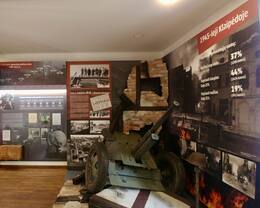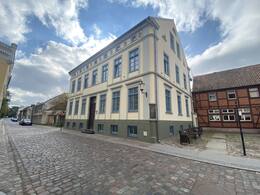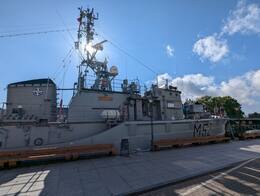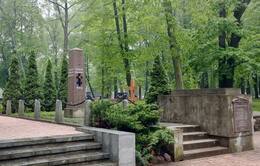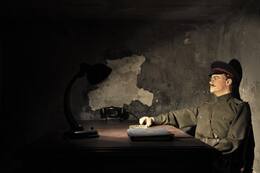Scenes of Soviet Lithuania
Day 1.
6 km
Klaipėda
Practical info
- The itinerary is intended as a guide - how to optimally travel a region or country, or two countries, with the aim of getting to know their military heritage;
- The driver must plan for himself - how many of the recommended objects and places he can explore in one day;
- Before traveling, you should check the opening hours of sightseeing places (museums, collections, fortifications, etc.);
- In places where advance registration is required (local guides, private collections, other), a visit must be booked, specifying the date and time. If the trip is canceled, the registered places must be informed;
- Accommodation must be booked in advance. Accommodation may be unavailable during the summer season, especially on the coast. Some catering establishments may not be open during the winter season;
- Choose not only summer for your trip, but also other seasons;
- The Latvian-Lithuanian-Estonian borders can be crossed by road freely without restrictions and at any time of the day. When entering from one country to another, you must have an ID card or passport with you;
- Visit tourist information centers where you can get additional information, brochures, and maps.
Sights
Exposition “Sovietmečio pėdsakais” (“In the Footsteps of the Soviet Era”) at the History Museum of Lithuania Minor
The exposition is located in the central part of Klaipėda. When the Soviets occupied Lithuania in 1940, Klaipėda and the region of Klaipėda were already part of the German Reich. In January 1945, Klaipėda was captured by the Red Army. According to the registration data of the war commandant, only 28 civilians were left in the town at the time. The new Soviet period in Klaipėda began. One repressive regime was replaced with another.
The exposition “Sovietmečio pėdsakais” (“In the Footsteps of the Soviet Era”) aims to reflect the Soviet era and the changes that began in the late 1990s and to help understand the complex Soviet atmosphere. The exposition tells the story of the new inhabitants, the construction of the “socialist” Klaipėda, the Soviet ideology and propaganda efforts, the desire to destroy everything that was national, folk and civic, as well as religious consciousness. Different stories and themes are revealed: the interior of a Soviet-era living room of an intelligent person illustrates the everyday life of people of that time; an improvised “red corner” and the Soviet slogans reflect the methods and banality of Soviet propaganda; a computer terminal demonstrates the construction of Blessed Virgin Mary, Queen of Peace Church in Klaipėda and its fate in 1957–1963, etc.
French Commissariat in Klaipėda
The French Commissariat is located in the Old Town of Klaipėda. After the First World War, the Treaty of Versailles separated the Klaipėda region (Memel Gebiet or Territoire de Memel) from Germany. In January 1920, the administration of the district was taken over from the German representative by the French-appointed administrator, Brigadier-General, Dominique Odry, who settled at 3 Perkasų Street (now Sukilėlių Street). Thus, from 1920–1923, the Prefecture became the seat of the French Commissariat General and the most important state institution in the Klaipėda region.
On 10–15 January 1923, a well-organised and successfully executed military operation organised by the Lithuanian government, the army and the Riflemen Union took place, which was known as the “Klaipėda County Uprising” for a long time. After that, Klaipėda was annexed to Lithuania. During the military operation, the 2nd (Pagėgiai) Battle Group of Special Task Force, led by Mykolas Kalmantas-Bajoras, broke into and occupied the Prefecture building. High Commissioner Gabriel Petisné was forced to raise the white flag and surrender.
In cultural history, the Prefecture is associated with the victory of the “rebels”, which was the final part of the annexation of Klaipėda. Therefore, the theatrical storming of the prefecture, which is imitated by the reconstructors of war history, is depicted when the annexation of Klaipėda to Lithuania is commemorated.
Mine countermeasures ship-museum M52 "Sūduvis"
The M52 “Sūduvis” mine countermeasures ship-museum is located on the Karališkoji Danės waterfront of Klaipėda, next to Castle Bridge.
It is a “Lindau” mine trawler class ship, built in 1956–1958 in West Germany. The mission of these ships is to detect and destroy sea mines. The hull was therefore made of Brazilian oak, the deck of teak, and the machinery, of non-magnetic metal.
From 1958 to 1999, the ship belonged to the German Navy and was named M1071 “Koblenz”. From 1978–1979, it was converted from a mine trawler to a mine hunter.
In 1999, the ship was transferred to the Lithuanian Navy. Navy ships are traditionally named after historical regions of Lithuania, so the received ship was also named M52 “Sūduvis”. The ship served Lithuania for 22 years, taking part in international and national exercises and operations. In 2021, the ship left the service of the Lithuanian Navy and was handed over to the Lithuanian Maritime Museum. Then, 52 “Sūduvis” was opened to the public and adapted for the needs of museum and educational use. The vessel on display has authentic operational equipment.
Sculpture Park in Klaipėda
The park is located in Klaipėda between K. Donelaičio, Liepų, Trilapio and S. Daukanto streets.
Sculpture Park in Klaipėda is a multi-layered witness to the history of the city and of the world. A cemetery, a park, a memorial, a place for art – all this and more can be accommodated in one area.
In 1944–1945, the Soviet occupiers regained their positions in ithuania, but Klaipėda was left without its old inhabitants. The once new, now old, city cemetery was left neglected. Finally, in 1977, it was disposed of, a Sculpture Park was built instead, and the installation of artworks began.
Today, the park is known as an open-air sculpture gallery of Lithuania’s mature modernism. 116 works created during the Soviet period (1977–1989) are on display here. Alongside works of art and relics of the ancient cemetery, monuments are also displayed here:
• Memorial to the events of the 1923 Klaipėda Uprising (1925);
• Memorial to the Soviet soldiers of World War II (1949–1980), part
of which was dismantled in 2022 after the outbreak of the war
of Russia against Ukraine;
• a memorial stone to the old inhabitants of Klaipėda – the
Memelenders (1992).
French prisoners of the Franco-Prussian War, German Imperial soldiers of the First World War, soldiers of Independent Lithuania, Belgian, Polish and French prisoners of the Second World War are also honoured with commemorative signs.
Exposition on Exile and Resistance Movement at the History Museum of Lithuania Minor
The exposition is located in the central part of Klaipėda.
After the Soviet occupation, the repressive structures (NKGB, KGB) in Klaipėda were located in the city buildings at 2 and 4 S. Nėries Street. People were imprisoned, interrogated and tortured here. Between 1945 and 1953, 8,268 people were imprisoned in the basement cells (the so-called inner prison) of the 4th house at S. Nėries Street. The KGB used these buildings until the mid-1990s when it moved to other premises.
In 1992, the building at 4 S. Nėries Street housed the Klaipėda Territorial Customs Office, and in 2014, an Exposition on Exile and Resistance Movement was opened in the basement
of the building. Visitors can see two authentic cells and a restored interrogation room. The exposition introduces the visitor to the Soviet repressive structures, the partisan war in Western Lithuania, the procedure of deportations carried out in Klaipėda region, and the stories of political prisoners. The peculiar history of the Klaipėda region (compared to other regions of Lithuania) determined the fact that the anti-Soviet movement also had its own peculiarities. In an improvised interrogation room, visitors are given the opportunity to experience the oppressive and terrifying environment that a person who’d fallen into the hands of repressive structures had to endure.




